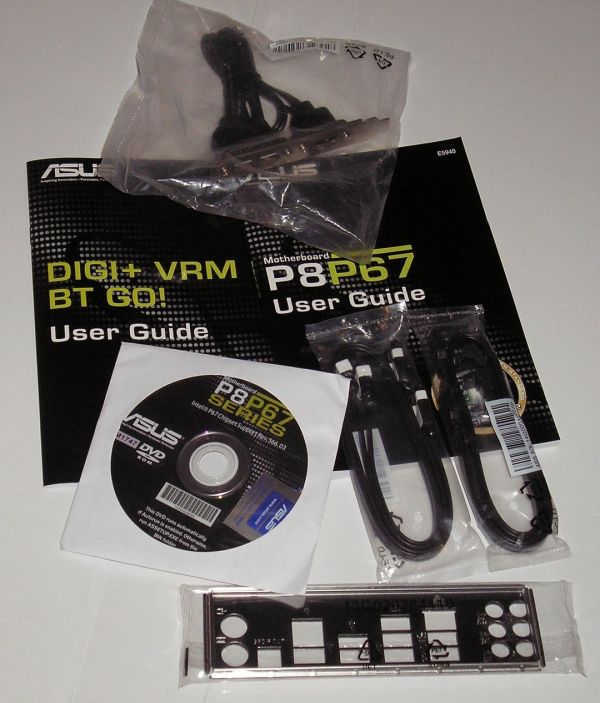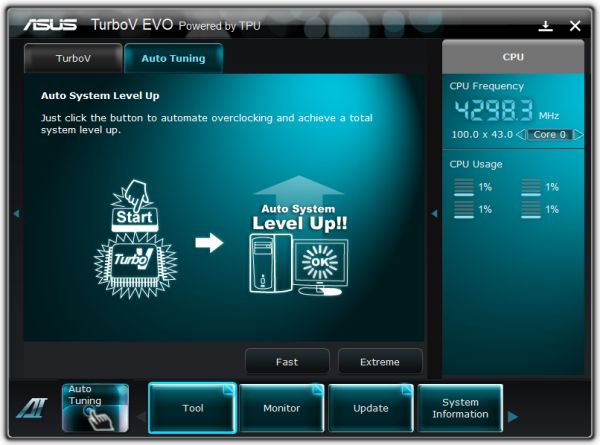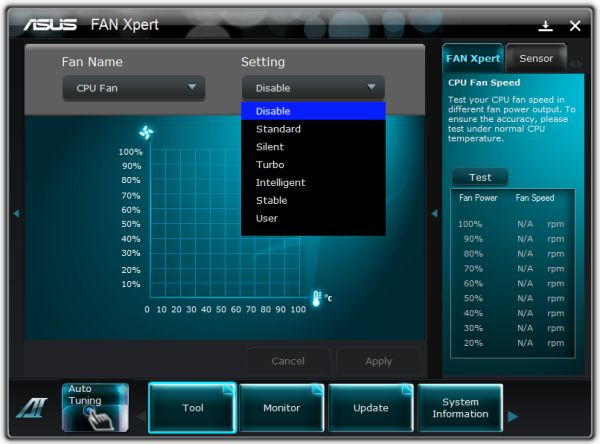ASUS P8P67 Review
by Brendan van Varik on September 8, 2011 10:45 AM EST- Posted in
- Asus
- Motherboards
- P67
Board Features
| ASUS P8P67 | |
| Market Segment | Performance |
| CPU Interface | LGA 1155 |
| CPU Support | Sandy Bridge i3/i5/i7 |
| Chipset | P67 |
| Base Clock Frequency | 38.0 MHz to 400.0 MHz in 0.1 MHz intervals |
| DDR3 Memory Speed | 1333 MHz by default, 800-2133 MHz supported |
| Core Voltage | Auto, offset or fixed modes, 0.800 V to 1.800 V in 0.015 V intervals |
| CPU Clock Multiplier | Dependant on CPU |
| DRAM Voltage | Auto, 1.108 V to 2.464 V in 0.007V intervals |
| DRAM Command Rate | Auto, 1T-3T |
| Memory Slots |
Four 240-pin DDR3 DIMM slots in dual-channel Regular unbuffered DDR3 memory Up to 32GB total supported |
| Expansion Slots |
2 x PCI Express 2.0 x16 slots (x16/x0 or x16/x4) 2 x PCI Express 2.0 x1 slot 3 x PCI slots Supports ATI Crossfire |
| Onboard SATA/RAID |
2 x SATA 6.0 Gb/s ports (gray) supporting RAID 0/1/5/10 4 x SATA 3.0 Gb/s ports (blue) supporting RAID 0/1/5/10 2 x SATA 6.0 Gb/s ports (navy blue) from Marvell 88SE9172 |
| Onboard |
4 x SATA 3Gb/s connectors 4 x SATA 6Gb/s connectors 4 x Fan Headers (1x4-pin, 3x3-pin) 3 x USB 2.0 headers support additional 8 USB 2.0 Ports 1 x Front panel switch/LED header 1 x TPM module connector 1 x USB3.0/2.0 header 1 x IEEE 1394a header 1x SPDIF Out header 1x Serial port header 1 x Firewire/IEEE 1394 header 1 x Front panel audio header 1x Clearing CMOS jumer |
| Onboard LAN | 1 x Realtek RTL8111E chip (10/100/1000 Mbit) |
| Onboard Audio | Realtek ALC889 Codec, 2/4/5.1/7.1-channel, Dolby Home Theater, S/PDIF Out |
| Power Connectors |
24-pin EATX Power connector 8-pin EATX 12V Power connector |
| Fan Headers |
1 x CPU Fan (4-pin) 3 x SYS Fan (3-pin) |
| IO Panel |
1 x PS/2 keyboard/mouse port 1 x optical S/PDIF Out connector 1 x DisplayPort 6 x USB 2.0/1.1 ports 1 x IEEE 1394a port 2 x USB 3.0/2.0 ports 1 x RJ-45 port 6 x audio jacks (Center/Subwoofer Speaker Out/Rear Speaker Out/Side Speaker Out/Line In/Line Out/Microphone) |
| BIOS |
1 x 32 Mbit flash Use of licensed AWARD BIOS Support for DualBIOS™ PnP 1.0a, DMI 2.0, SM BIOS 2.4, ACPI 1.0b |
| Warranty Period | 3 Years |
What’s in the box?
A users guide to the motherboard and DIGI+ VRM/BT GO!
Driver and utilities DVD
2x SATA 6Gb/s cables
2x SATA 3Gb/s cables
1x 2-port USB / 1 eSATA PCI bracket
1x 2-in-1 ASUS Q-Connector kit
I/O Shield
ASUS sticker
There are a few extras included with this motherboard. ASUS have kept it down to minimize costs and they did not include the USB 3.0 front panel with this motherboard although they do include it with their more expensive options. It is a shame; I would have liked to see one with this board, especially when you consider that the ASRock P67 Extreme4 comes with one and is in a similar price bracket.
Software
When it comes down to installing the software for the motherboard, you can choose to install the software one by one or you can install all of them at once. In this case, everything was installed to ensure a fair test. The installation was straight forward. If you select the ‘InstAll’ option, the computer will install all of the drivers and restart a total of three times during the process of installation.
ASUS AI Suite II
The AI Suite II has a vast amount of programs installed within it. The program initially loads in a thin bar which allows you access the various parts of it by clicking on whichever part of the software you wish to use.
The Auto Tuning feature that you can see on the left is something which will automatically overclock your PC for you. There are two different pre-sets which are ‘Fast’ and ‘Extreme’. I have been over these in detail with my experiences in the overclocking section of this review.
ASUS FAN Xpert allows you to create custom fan profiles. You can choose from various preset settings as well as a ‘user’ option which allows you to change the fans to your requirements. When you choose the user option, you can choose where and when the fans start to ramp up. In all fairness, there are enough options within the FAN Xpert to satisfy most people but every one of us may have a slightly different perception of what the ideal settings should be.
Finally, we have the Update and System Information tabs. They pretty much speak for themselves - you can update your EFI revision from within Windows using this feature. If you want to update your EFI using this method, do this at your own risk. The best way to ensure a flawless update is at default EFI settings. The ‘System Information’ tells you about your CPU, motherboard and RAM, sort of like an in-built CPU-Z.




















52 Comments
View All Comments
Blaster1618 - Thursday, September 8, 2011 - link
I am so tired of LGA-1155 being portrayed as an "Enthusiast Board"-Dual-channel memory.
-Narrow PCI Bus.
-Virtually fixed core clock.
-and the stake to the heart....on board graphics.
Wait...wait LGA-2011 and i7 3-series will spice up the M-board review business.
zero2dash - Thursday, September 8, 2011 - link
Troll much?Onboard graphics has no performance penalty on a 2600K (let alone a 2500K) so throw that piss poor reason out the window.
Narrow PCI bus? Yes, because that's clearly dragging SB systems through the mud. So is the dual channel memory.
Fixed core clock? Who gives a crap? Yeah, because a locked core clock with an unlocked multiplier is a worse option than an unlocked core clock and a limited amount of multiplier options.
Have fun paying for those quad channel ram kits.
A5 - Thursday, September 8, 2011 - link
A) Memory bandwidth has very little discernible effect on non-benchmark applications. Modern CPUs are so good at cache management that there is almost 0 reason to chase memory bandwidth. Ironically, the 1156 CPUs probably need the bandwidth more (due to the onboard graphics) than the 2011 CPUs will.B) If you need more than two PCI-e x8 slots, then you're the kind of person who will drop the cash on LGA-2011 anyway. This is a legit knock against P67 and Z68, but it also only affects the hardcore enthusiasts, the top 1% of the top 1% who are running 3 or 4 GPUs.
C) LGA-2011 is going to have fixed clocks too. With multipliers unlocked, this is kind of a moot point anyway.
D) Considering P67 doesn't even allow you to use the onboard graphics, I don't see how this is a valid complaint.
I think P67 is a perfectly acceptable "enthusiast" product, and honestly I'd be surprised if there is an LGA-2011 version of Ivy Bridge outside of the server space.
RussianSensation - Thursday, September 8, 2011 - link
You should leave him alone :)He is probably going to future-proof his LGA-2011 setup with 32GB (4x8GB) for $1200:
http://www.newegg.com/Product/Product.aspx?Item=N8...
....because 32GBs in Quad-Channel LGA2011 Pawwwwwwwns all!
Blaster1618 - Saturday, September 10, 2011 - link
Not Hating... but I figured as soon as the Z series board was out, the H&P series boards would drop, rightfully so, in the bargain bin.I obvious to me that the 2nd generation i7 have an internal memory architecture limitation. (ie they were not designed for enthusiasts) Cut and paste old North Bridge architecture on the die. The bandwidth(bitwidth) of the internal communication 3rd generation chips is nearly twice the 2nd generation and it has 20 Gbit DMI 2.0.
If you don't believe bandwidth matters, I have a bin full old 64 bit Geforce cards for sale. I play games on my X-box, My computers for Solid modeling and Finite element analysis and surfing pron.
I was under the understanding the issues with the base clock adjust-ability were issues with the on board GPU's sensitivity to frequency. I am hoping the base clock on the I7 3820 will have 30-40% overclock like the LGA1366 or my old E6600.
At <$300 the i7 3820 should be quite a deal ps my business picks up the $1,200 for the 32 GB of Corsair XMS.
RussianSensation - Thursday, September 8, 2011 - link
2500k - $220This board - $135
vs. i7-990X
http://www.xbitlabs.com/articles/cpu/display/core-...
Care to explain how a $355 mobo+cpu setup trades blows with an overclocked $999 i7 CPU on "enthusiast" LGA1366?
I hope you enjoy your $300 LGA2011 Motherboard + $500-1000 CPU for 1 quarter until IVB launches and obsoletes LGA2011 for anyone but workstation users.
Etern205 - Friday, September 9, 2011 - link
pfff....Yep, have fun waiting for that Ivy Bridge of yours....
http://vr-zone.com/articles/the-upgrade-path-to-iv...
CharonPDX - Thursday, September 8, 2011 - link
If you've used any Intel Desktop Board in the past three years, you've used a UEFI-based configuration utility. It's just one designed to look like an old fashioned 'BIOS' screen. (P.S., technically it hasn't been a "BIOS" in a while, it's been a configuration utility.)Concillian - Thursday, September 8, 2011 - link
So why is the P8P67 consuming 20 more watts at idle than the P8P67 Pro in it's review?Shouldn't the less featured board be using less power?
Mumrik - Thursday, September 8, 2011 - link
I looked around for a relatively cheap motherboard with 8+ SATA ports for a 2500k and this board was by far the cheapest. Reading up in forums (especially at the [H] where Asus is active) and at Newegg I got the impression that there was an unusual amount of problems with the generation of Asus boards, so I chickened out and picked up an Asrock instead.